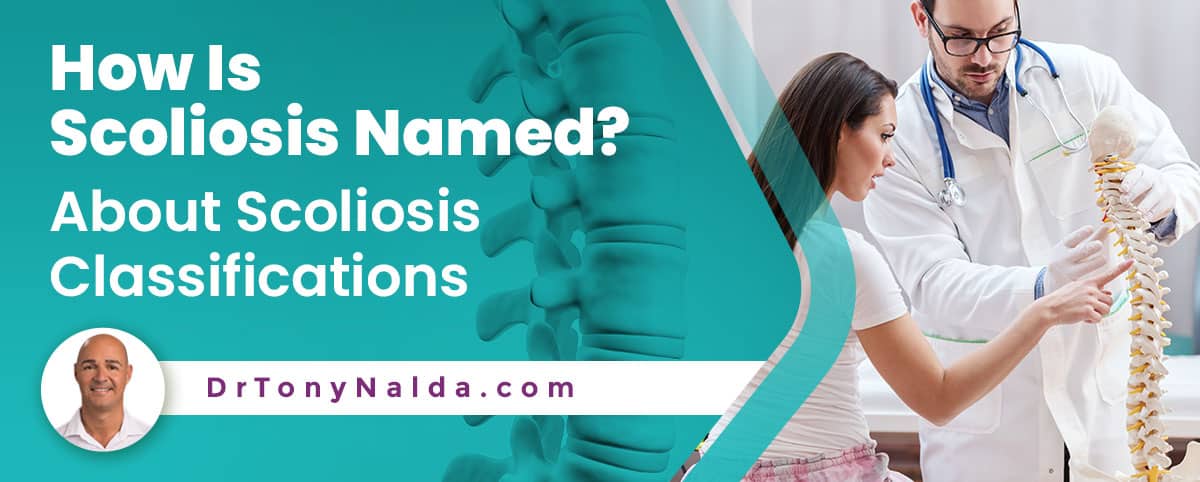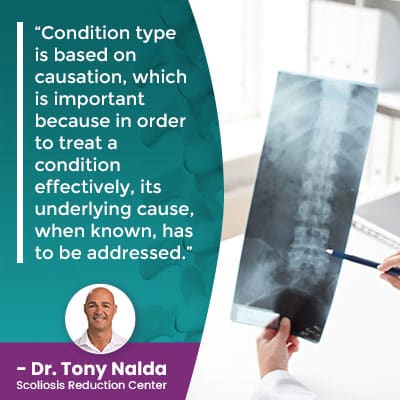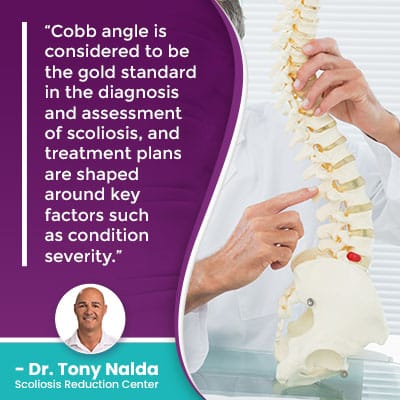How Is Scoliosis Named? About Scoliosis Classifications

Scoliosis is named based on its classification points, and customized treatment plans are crafted around these variables; this is what the complex nature of the condition necessitates. Continue reading for a better understanding of how a condition is diagnosed and further classified.
To reach a diagnosis of scoliosis, a number of parameters have to be met, and this involves comprehensive assessment. Scoliosis is classified based on key patient/condition variables: patient age, condition type, curvature location and condition severity.
To start our discussion of how scoliosis is named, let’s talk about how it’s diagnosed, as classifying a condition is a key part of the process.
Table of Contents
Diagnosing Scoliosis
Diagnosing scoliosis involves a physical examination performed by a medical professional and X-ray imaging to really see what’s happening in and around the spine.
Scoliosis is the development of an unnatural sideways spinal curve, with rotation, meaning it also twists from front to back, back to front, making it a 3-dimensional condition.
A scoliotic curve also has to be of a minimum size, which we’ll return to later when discussing condition severity, and if those parameters are met, a diagnosis of scoliosis can be reached.
Scoliosis is a structural spinal condition, meaning treatment has to, first and foremost, impact it on a structural level.
In addition, scoliosis is progressive, meaning it has it in its nature to get worse over time, and this is why being proactive with treatment can be so beneficial.
While there are never treatment guarantees, scoliosis that’s detected early, when responded to with proactive conservative treatment, can be highly treatable.
Scoliosis getting worse means that the size of the unnatural spinal curve is increasing, as are the ocndition’s uneven forces, and their effects.
While each case is unique, there are some common scoliosis symptoms, and the main symptom of scoliosis in children is postural deviation such as uneven shoulders, hips, and the development of a rib arch.
The main symptom of scoliosis in adults is pain, and this is because scoliosis becomes a progressive condition in adulthood, once skeletal maturity has been reached.
Growing spines are experiencing a constant lengthening motion, and this counteracts the compressive force of the unnatural spinal curve, which doesn’t just affect the spine, but also its surrounding muscles and nerves.
So now that we’ve discussed how scoliosis is diagnosed, along with some of its key characteristics, let’s move on to each of its classification points: age, type, location, and severity.
Patient Age
Scoliosis can affect all ages from babies to the elderly and every age in between.
Patient age is a key factor because it indicates whether or not a condition is going to require pain management as a focus of treatment, if natural age-related spinal degeneration is likely to be a factor, and its potential rate of progression.
While we don’t always know what causes the initial onset of scoliosis, we do fully understand what triggers its progression: growth and development.
So in children and adolescents, we know that monitoring closely for signs of progression is important, particularly for adolescents in the stage of puberty: characterized by rapid and unpredictable growth spurts.
Congenital scoliosis refers to babies born with the condition; infantile scoliosis refers to scoliosis diagnosed in infants between the ages of 6 months and 3 years.
Early-onset juvenile scoliosis involves children between the ages of 3 and 10, with adolescent idiopathic scoliosis (AIS), diagnosed between the ages of 10 and 18, and adult scoliosis is diagnosed in individuals who have reached skeletal maturity.
Condition Type
 Condition type is based on causation, which is important because in order to treat a condition effectively, its underlying cause, when known, has to be addressed.
Condition type is based on causation, which is important because in order to treat a condition effectively, its underlying cause, when known, has to be addressed.
The most common type of scoliosis to affect children and adults is classified as idiopathic, meaning not clearly associated with a single-known cause, and adolescent idiopathic scoliosis is the most prevalent type overall.
Approximately 80 percent of known diagnosed cases are classified as idiopathic, and the remaining 20 percent are associated with known causes: neuromuscular, degenerative, and congenital.
Neuromuscular scoliosis is caused by the presence of a larger neuromuscular condition such as muscular dystrophy, spina bifida, or cerebral palsy.
Congenital scoliosis is a rare form, affecting 1 in 10,000, and babies are born with the condition as it’s caused by a malformed spine that develops in utero
Degenerative scoliosis is most common in adults over the age of 50, is more prevalent in females than males, and is caused by natural age-related spinal degeneration.
Idiopathic cases are considered typical with a right-bending curve that bends away from the heart, while cases of neuromuscular, degenerative, and congenital scoliosis can be considered atypical as curves can also bend to the left, towards the heart.
When I see a left-bending curve, this is a red flag that there is an underlying pathology, and this complicates the treatment process because a condition’s underlying cause has to be the focus of treatment.
Curvature Location
There are three main spinal sections, and scoliosis can develop in any: cervical spine (neck), thoracic spine (middle/upper back), and the lumbar spine (lower back).
Scoliosis most often involves the thoracic spine as this is the largest of the spinal sections, and it can also involve more than one section; for example, thoracolumbar scoliosis is a common type that develops in the lower thoracic and upper lumbar spine as a combined scoliosis.
Curvature location tells me where to concentrate my treatment efforts, as well as indicating which section of the body is going to be the most affected.
While scoliosis can affect the entire body, its direct effects are going to be felt by the area closest to the affected spinal section, so this indicates some likely symptoms.
Condition Severity
Condition severity is determined by a measurement known as Cobb angle, and as mentioned earlier, condition severity is one of the parameters that have to be met in order to reach a diagnosis of scoliosis.
In addition to a scoliotic curve bending and twisting unnaturally, it also has to be of a minimum size: Cobb angle measurement of at least 10 degrees.
The higher a Cobb angle, the more severe a condition:
- Mild scoliosis: Cobb angle of between 10 and 25 degrees
- Moderate scoliosis: Cobb angle measurement of between 25 and 40 degrees
- Severe scoliosis: Cobb angle of 40+ degrees
- Very-severe scoliosis: Cobb angle of 80+ degrees
The condition’s severity levels are also its progressive line, so where a scoliosis is at the time of diagnosis isn’t indicative of where it will stay.
When the spine’s healthy curves are in place, its vertebrae (bones of the spine) are aligned and stacked on top of one another as they should be, but as scoliosis develops, vertebrae are becoming tilted, shifting them out of alignment with the rest of the spine.
Condition severity tells me how severe a condition is, where it is on its progressive line, and indicates how noticeable a condition’s effects are going to be.
 Cobb angle is considered to be the gold standard in the diagnosis and assessment of scoliosis, and treatment plans are shaped around key factors such as condition severity.
Cobb angle is considered to be the gold standard in the diagnosis and assessment of scoliosis, and treatment plans are shaped around key factors such as condition severity.
Conclusion
Part of diagnosing scoliosis involves comprehensive assessment so it can be further classified based on key patient/condition variables that vary from patient to patient.
Scoliosis is often deemed a complex condition to treat, and this is because not only is the condition progressive, it can range so widely in severity, affects all ages, can develop anywhere along the spine, and also has different types.
The many fluctuating condition variables necessitates the customization of effective treatment plans.
Patient age, condition type, curvature location, and condition severity inform the crafting of customized treatment plans, and when a proactive conservative treatment plan addresses each of these variables, treatment success is more likely.
Here at the Scoliosis Reduction Center, I apply a conservative treatment approach that integrates multiple different types of treatment so conditions are impacted on every level.
Through condition-specific chiropractic care, physical therapy, corrective bracing, and rehabilitation, patients can experience corrective results in the form of a curvature reduction, increasing core strength so the spine is optimally supported by its surrounding muscles, the spine being pushed into a corrective position through ultra-corrective bracing, and rehabilitation involving custom-prescribed home exercises used to further stabilize the spine.
As a progressive spinal condition, the best time to start scoliosis treatment, regardless of age, type, location, or severity is always now; while I can never give treatment guarantees, when scoliosis is detected early and responded to proactively, there are fewer limits to what can be achieved.
Dr. Tony Nalda
DOCTOR OF CHIROPRACTIC
After receiving an undergraduate degree in psychology and his Doctorate of Chiropractic from Life University, Dr. Nalda settled in Celebration, Florida and proceeded to build one of Central Florida’s most successful chiropractic clinics.
His experience with patients suffering from scoliosis, and the confusion and frustration they faced, led him to seek a specialty in scoliosis care. In 2006 he completed his Intensive Care Certification from CLEAR Institute, a leading scoliosis educational and certification center.
About Dr. Tony Nalda
 Ready to explore scoliosis treatment? Contact Us Now
Ready to explore scoliosis treatment? Contact Us Now





